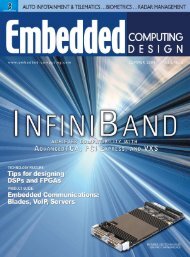CompactPCI and AdvancedTCA Systems - OpenSystems Media
CompactPCI and AdvancedTCA Systems - OpenSystems Media
CompactPCI and AdvancedTCA Systems - OpenSystems Media
You also want an ePaper? Increase the reach of your titles
YUMPU automatically turns print PDFs into web optimized ePapers that Google loves.
T E C H N O L O G Y<br />
I N T E R N E T M O D E M S<br />
Traditional modems have an advantage over iModems because<br />
they can be programmed to answer an incoming call. iModems<br />
may only call out to send or retrieve information. This makes it<br />
difficult to initiate an update from a location remote to the device<br />
to be polled. With the traditional modem, the unit just needs to be<br />
called to gain access. With iModems it may be done in two ways:<br />
■ Use the web page hosting ability<br />
■ Send an e-mail to each device<br />
When using the web hosting ability, each field modem has a<br />
resident web page that is updated or interrogated by the product’s<br />
resident microprocessor on a regular basis. The interrogation<br />
of data is done by accessing the web page <strong>and</strong> procuring<br />
the updated data when present. With software updates the field<br />
device is told to interrogate its web page when an FTP flag is set<br />
at the web host.<br />
With an e-mail transfer, the e-mail previously sent with a new<br />
software update waits to be interrogated. Each field device makes<br />
the local call to retrieve its e-mail based on an FTP flag or time<br />
of day algorithm, or some local event. The information is downloaded<br />
<strong>and</strong> then acted upon.<br />
Remote downloads of field upgradeable parameters<br />
When products are deployed in the field there is often a need<br />
to change the setup parameters. Traditional modems require<br />
very little in the way of setup, <strong>and</strong> they are generally not field<br />
upgradeable. An iModem requires many more parameters to be<br />
programmed to provide its Internet personality, such as passwords,<br />
local access numbers, <strong>and</strong> e-mail addresses. Occasionally<br />
these parameters have to be changed after field installation. The<br />
iModem has the ability to remotely change these parameters<br />
under protected administrative control, thus avoiding the need<br />
for field service calls or return to the factory modifications.<br />
Parameters that often need to be changed are passwords <strong>and</strong> local<br />
access numbers to the ISP.<br />
Data transfer speed<br />
High-speed traditional modems on long distance lines often connect<br />
at lower speeds than expected due to the characteristic of the<br />
telephone line, particularly when long distance is involved. Also<br />
long distance connections can cause error correcting communication<br />
software to kick in, in turn causing the transfer of data to run<br />
more slowly since the modem may have to retransmit blocks of<br />
data. The iModem offers advantages since all access is via local<br />
access numbers <strong>and</strong> local telephone calls. The Internet data at the<br />
local ISP host site is multiplexed <strong>and</strong> concentrated on to higher<br />
speed T1 or greater conditioned or optical lines. This plus the<br />
local nature of the access call ensures that the communication<br />
link will run at a higher speed with the iModem.<br />
Conclusion<br />
The advantages of the traditional modem are:<br />
■ Low hardware cost<br />
■ Simplicity of use<br />
■ Variable communications costs based on usage<br />
■ The ability to easily poll remote field units<br />
This must be metered against the advantages of the Internet<br />
modem, which offers:<br />
■ Fixed predictable communications cost<br />
■ No central host hardware or maintenance cost<br />
■ Higher data rate<br />
■ Universal, well-understood networks with data retention<br />
There is an alternative to the traditional embedded modem, namely<br />
the Internet modem. Both have advantages in some applications,<br />
but in the long run the Internet accessibility will win out.<br />
Howard Raphael is president of Cermetek Microelectronics,<br />
Inc. He received his BSEE from Rochester Institute of<br />
Technology <strong>and</strong> is a graduate of the Stanford University<br />
Executive Institute. Prior to joining Cermetek, Howard was<br />
a group director at National Semiconductor, <strong>and</strong> before that<br />
was a product manager at Intel. He has published numerous<br />
articles about microprocessors, modems, <strong>and</strong> appliance<br />
modems <strong>and</strong> holds several patents.<br />
To learn more, contact Howard at:<br />
RSC# 30 @www.compactpci-systems.com/rsc<br />
Cermetek Microelectronics<br />
1390 Borregas Avenue<br />
Sunnyvale, CA 94089<br />
Tel: 408-752-5000 • Fax: 408-752-5004<br />
E-mail: staff@cermetek.com<br />
Website: www.cermetek.com<br />
30 / <strong>CompactPCI</strong> <strong>and</strong> <strong>AdvancedTCA</strong> <strong>Systems</strong> / September 2005

















